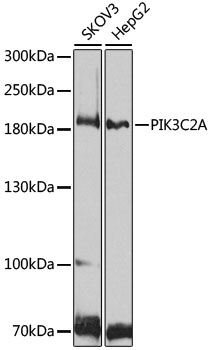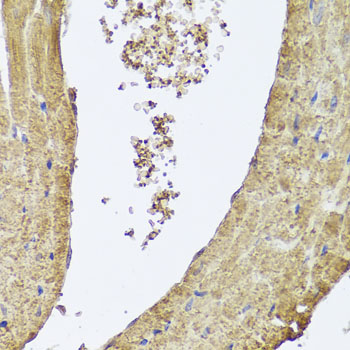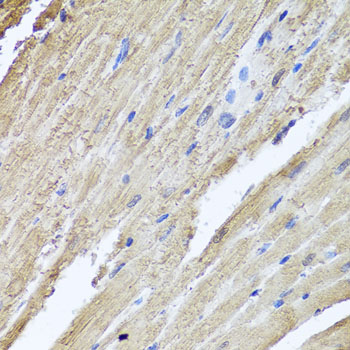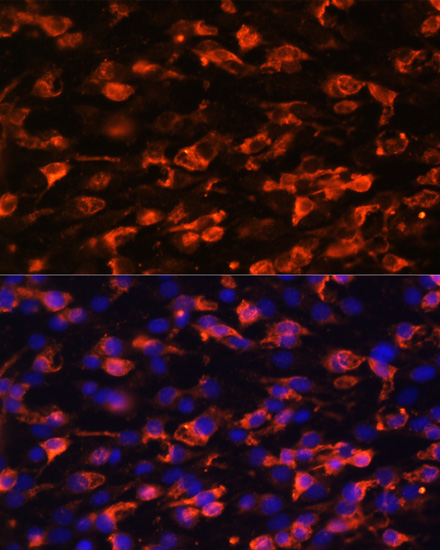Cell Biology Antibodies 12
Anti-PIK3C2A Antibody (CAB8526)
- SKU:
- CAB8526
- Product Type:
- Antibody
- Applications:
- WB
- Applications:
- IHC
- Applications:
- IP
- Reactivity:
- Human
- Reactivity:
- Mouse
- Reactivity:
- Rat
- Host Species:
- Rabbit
- Isotype:
- IgG
- Research Area:
- Cell Biology
Description
| Antibody Name: | Anti-PIK3C2A Antibody |
| Antibody SKU: | CAB8526 |
| Antibody Size: | 20uL, 50uL, 100uL |
| Application: | WB IHC IF IP |
| Reactivity: | Human, Mouse, Rat |
| Host Species: | Rabbit |
| Immunogen: | Recombinant fusion protein containing a sequence corresponding to amino acids 1-200 of human PIK3C2A (NP_002636.2). |
| Application: | WB IHC IF IP |
| Recommended Dilution: | WB 1:500 - 1:2000 IHC 1:50 - 1:100 IF 1:50 - 1:100 IP 1:50 - 1:100 |
| Reactivity: | Human, Mouse, Rat |
| Positive Samples: | SKOV3, HepG2 |
| Immunogen: | Recombinant fusion protein containing a sequence corresponding to amino acids 1-200 of human PIK3C2A (NP_002636.2). |
| Purification Method: | Affinity purification |
| Storage Buffer: | Store at -20'C. Avoid freeze / thaw cycles. Buffer: PBS with 0.02% sodium azide, 50% glycerol, pH7.3. |
| Isotype: | IgG |
| Sequence: | MAQI SSNS GFKE CPSS HPEP TRAK DVDK EEAL QMEA EALA KLQK DRQV TDNQ RGFE LSSS TRKK AQVY NKQD YDLM VFPE SDSQ KRAL DIDV EKLT QAEL EKLL LDDS FETK KTPV LPVT PILS PSFS AQLY FRPT IQRG QWPP GLPG PSTY ALPS IYPS TYSK QAAF QNGF NPRM PTFP STEP IYLS LPGQ SPYF SYPL |
| Gene ID: | 5286 |
| Uniprot: | O00443 |
| Cellular Location: | Cell membrane, Cytoplasm, Cytoplasmic vesicle, Golgi apparatus, Nucleus, clathrin-coated vesicle |
| Calculated MW: | 53kDa/190kDa |
| Observed MW: | 191kDa |
| Synonyms: | PIK3C2A, CPK, PI3-K-C2(ALPHA), PI3-K-C2A, PI3K-C2-alpha, PI3K-C2alpha |
| Background: | The protein encoded by this gene belongs to the phosphoinositide 3-kinase (PI3K) family. PI3-kinases play roles in signaling pathways involved in cell proliferation, oncogenic transformation, cell survival, cell migration, and intracellular protein trafficking. This protein contains a lipid kinase catalytic domain as well as a C-terminal C2 domain, a characteristic of class II PI3-kinases. C2 domains act as calcium-dependent phospholipid binding motifs that mediate translocation of proteins to membranes, and may also mediate protein-protein interactions. The PI3-kinase activity of this protein is not sensitive to nanomolar levels of the inhibitor wortmanin. This protein was shown to be able to be activated by insulin and may be involved in integrin-dependent signaling. |
| UniProt Protein Function: | PIK3C2A: a protein of the phosphoinositide 3-kinase (PI3K) family. PI3-kinases play roles in signaling pathways involved in cell proliferation, oncogenic transformation, cell survival, cell migration, and intracellular protein trafficking. This protein contains a lipid kinase catalytic domain as well as a C-terminal C2 domain, a characteristic of class II PI3-kinases. C2 domains act as calcium-dependent phospholipid binding motifs that mediate translocation of proteins to membranes, and may also mediate protein-protein interactions. Its PI3-kinase is not sensitive to nanomolar levels of the inhibitor wortmannin. Activated by insulin and may be involved in integrin-dependent signaling. |
| UniProt Protein Details: | Protein type:Carbohydrate Metabolism - inositol phosphate; Autophagy; Kinase, lipid; EC 2.7.1.154; Motility/polarity/chemotaxis Chromosomal Location of Human Ortholog: 11p15.5-p14 Cellular Component: cytoplasm; cytosol; membrane; phosphoinositide 3-kinase complex; plasma membrane; vesicle Molecular Function:1-phosphatidylinositol-3-kinase activity; phosphatidylinositol-4-phosphate 3-kinase activity; phosphoinositide 3-kinase activity Biological Process: clathrin cage assembly; endocytosis; epidermal growth factor receptor signaling pathway; exocytosis; insulin receptor signaling pathway; phosphatidylinositol biosynthetic process; platelet-derived growth factor receptor signaling pathway; vascular smooth muscle contraction |
| NCBI Summary: | The protein encoded by this gene belongs to the phosphoinositide 3-kinase (PI3K) family. PI3-kinases play roles in signaling pathways involved in cell proliferation, oncogenic transformation, cell survival, cell migration, and intracellular protein trafficking. This protein contains a lipid kinase catalytic domain as well as a C-terminal C2 domain, a characteristic of class II PI3-kinases. C2 domains act as calcium-dependent phospholipid binding motifs that mediate translocation of proteins to membranes, and may also mediate protein-protein interactions. The PI3-kinase activity of this protein is not sensitive to nanomolar levels of the inhibitor wortmanin. This protein was shown to be able to be activated by insulin and may be involved in integrin-dependent signaling. [provided by RefSeq, Jul 2008] |
| UniProt Code: | O00443 |
| NCBI GenInfo Identifier: | 152031652 |
| NCBI Gene ID: | 5286 |
| NCBI Accession: | O00443.2 |
| UniProt Secondary Accession: | O00443,Q14CQ9, B0LPH2, B4E2G4, |
| UniProt Related Accession: | O00443 |
| Molecular Weight: | 53,742 Da |
| NCBI Full Name: | Phosphatidylinositol 4-phosphate 3-kinase C2 domain-containing subunit alpha |
| NCBI Synonym Full Names: | phosphatidylinositol-4-phosphate 3-kinase catalytic subunit type 2 alpha |
| NCBI Official Symbol: | PIK3C2A |
| NCBI Official Synonym Symbols: | CPK; PI3-K-C2A; PI3K-C2alpha; PI3K-C2-alpha; PI3-K-C2(ALPHA) |
| NCBI Protein Information: | phosphatidylinositol 4-phosphate 3-kinase C2 domain-containing subunit alpha |
| UniProt Protein Name: | Phosphatidylinositol 4-phosphate 3-kinase C2 domain-containing subunit alpha |
| UniProt Synonym Protein Names: | Phosphoinositide 3-kinase-C2-alpha |
| Protein Family: | Phosphatidylinositol 4-phosphate 3-kinase C2 domain-containing |
| UniProt Gene Name: | PIK3C2A |
| UniProt Entry Name: | P3C2A_HUMAN |
View AllClose











